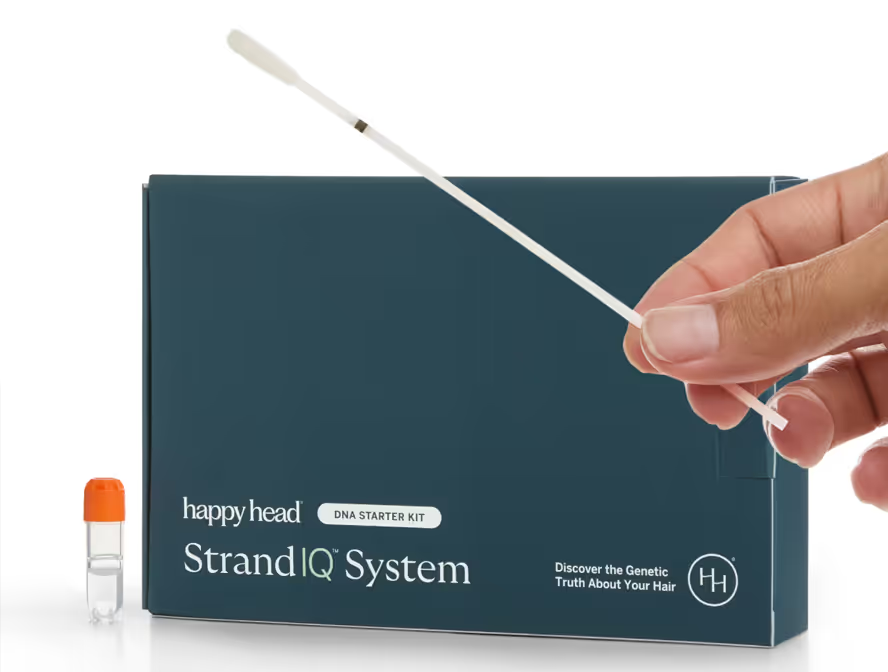Is your hair snapping more easily than usual? Struggling with split ends or thinning along your hairline? You could be dealing with hair breakage, a common issue that stems from weakened strands rather than hair loss at the root. Unlike shedding or balding, breakage is all about the structural integrity of the hair shaft—and one key player in that equation is keratin.
Let’s explore what makes hair more prone to breakage, how keratin levels and your DNA come into play, and what you can do to restore strength—based on your Happy Head StrandIQ™ genetic risk level.
What Is Hair Breakage and Why Does It Happen?
Hair breakage occurs when the hair shaft becomes so fragile that it physically snaps—whether from brushing, heat styling, or just daily wear and tear. The main structural protein responsible for your hair’s resilience is keratin, which forms both the internal cortex and the protective outer cuticle of each strand.
Here’s what we know:
- Keratin is a protein naturally produced by your body, but its levels can decrease with age, damage, or certain genetic variants.
- When keratin is depleted or its structure is compromised, hair becomes brittle, dull, and prone to breaking—especially at stress points like the ends or around tight hairstyles.
- Environmental exposures—UV rays, salt water, wind, and chemical processing—can strip keratin from your strands.
- Genetics play a role, too. Variants in genes linked to keratin type II expression can make some people more vulnerable to fragility—even with gentle styling.
How Genetics Impact Hair Strength and Breakage
If your hair seems naturally prone to breakage, your DNA might be part of the equation. Certain genes control the production of keratin, the protein that forms both the structure and outer layer of each hair strand. Variations in keratin-related genes—especially keratin type II genes like KRT81, KRT83, and KRT86—can weaken the hair shaft, making it more vulnerable to breakage from heat, styling, and environmental stress.
In short: if you’ve inherited lower keratin expression, your hair may need more targeted support. That could mean prioritizing keratin-infused products, protective styles, and avoiding anything that stresses or strips the hair shaft.
Hair Breakage Treatment Options, Sorted by Risk Level
There’s no one-size-fits-all treatment for hair breakage, but there are plenty of options. At Happy Head, we believe in smart, layered care: start with the basics, then build up if you need more help.
Low-Risk Options: Daily Habits That Protect Hair from Breakage
If Happy Head’s StrandIQ analysis shows you're at low risk for hair fragility, you may just need a few tweaks to keep your strands strong:
- Choose keratin-infused shampoos and conditioners
These products can help temporarily reinforce weakened strands by depositing keratin on the cuticle surface. - Avoid overwashing
Shampooing too often can strip natural oils and proteins. Aim for 2–3 washes per week, and follow with conditioner. - Protect your hair from the elements
UV rays, salt water, and dry wind can all damage keratin. Use protective styles, wear hats outdoors, and rinse hair after swimming.
Medium-Risk Options: Strengthen and Shield Your Hair
If you're at moderate risk for breakage, or you're seeing early signs like split ends or increased snapping, it’s time to take a more proactive approach:
- Dial back heat tools
High heat breaks down keratin. Use heat protectant sprays and keep your dryer or flat iron on low to medium settings. - Switch to breakage-reducing formulas
Look for shampoos, conditioners, and serums that target anti-breakage, protein repair, or bond strengthening—especially those with hydrolyzed keratin, biotin, or amino acids. - Deep-condition regularly
Weekly or biweekly deep conditioning treatments help restore moisture balance and rebuild the protective cuticle layer.
High-Risk Options: Clinical and Specialist Support for Hair Fragility
For those with high risk of hair breakage, including those with known keratin-related genetic variants or signs of advanced fragility (like excessive shedding, mid-shaft splits, or breakage at the root), more targeted care is key:
- Use keratin-infused products regularly
Aim for biweekly treatments or masks with hydrolyzed keratin and protein-building ingredients. - Avoid excessive chemical processing
Frequent coloring, relaxing, or bleaching can break down keratin bonds. Talk to your stylist about gentler options or longer intervals between treatments. - Style smarter
If you wear weaves or extensions, make sure they're lightweight and not placing tension on the scalp. Opt for silk pillowcases and avoid tight styles that cause stress at the roots. - Consult with a hair care professional
A dermatologist can assess keratin levels, rule out underlying causes, and recommend professional treatments like bond-building salon therapies, low-level laser therapy (LLLT), or protein-based prescription products.
Final Thoughts: You Can Strengthen Weak, Fragile Hair
Hair breakage can be frustrating—but it's also manageable. Whether you’re experiencing early signs or more advanced fragility, the right combination of care, products, and insight into your genetic profile can help rebuild strength from the inside out.
At Happy Head, we believe in personalized hair health, backed by science. From your genetic risk factors to your lifestyle and styling routine, we help you understand what your hair needs to stay strong—and keep growing.
Resources:
StrandIQ SNP Marker Count: 5
StrandIQ Genes for Trait:
KRT81, KRT83, KRT84, KRT85, KRT86
References:
Chabchoub, I., et al. (2012). Novel missense mutation in the KRT81 gene in a Tunisian family with monilethrix. Experimental Dermatology, 21(6), 477–480.
Cruz, C.F., Azoia, N.G., Cavaco-Paulo, A. (2017). Interactions between peptide molecules and human hair keratins. International Journal of Biological Macromolecules, 101, 805–814.
Djabali, K., Heller, M., Aita, V.M., Christiano, A.M. (2003). A missense mutation in the helix initiation motif of keratin 86 (KRT86) causes monilethrix. Human Genetics, 113(2), 142–147.
Djabali, K., Horev, L., Aita, V.M., Vardi, G., Sprecher, E. (2013). Monilethrix: Novel mutations in the helix termination motif of type II hair keratin genes KRT81 and KRT86. Journal of Investigative Dermatology, 133(4), 1202–1204.
Genomics England PanelApp. (2024). Hair disorders gene panel (includes KRT81, KRT83, KRT86). Version 1.31.
Jensen Disease Resource. (2025). KRT85 downregulation in ectodermal dysplasia and hair structure disorders.
Langbein, L., et al. (1999). The catalog of human hair keratins. I. Expression of the nine type I members in the hair follicle. Journal of Biological Chemistry, 274(13), 19874–19884.
Li, M., et al. (2021). Tissue-specific gene expression analysis for human transcriptomics studies: Insights from GTEx dataset. Human Genomics, 15(1), 58.
Ma’ayan Lab, Harmonizome Database. (2025). Expression and downregulation patterns of KRT81, KRT83, KRT86 in alopecia and hair texture studies.
Schweizer, J., Langbein, L., Rogers, M.A., Winter, H. (2007). Hair follicle-specific keratins and their diseases. Experimental Cell Research, 313(10), 2010–2020.
Shah, Y., et al. (2017). A novel homozygous frameshift mutation in the KRT83 gene underlies progressive symmetric erythrokeratoderma in a Pakistani family. Journal of Medical Genetics, 54(4), 273–277.
Szklarczyk, D., et al. (2019). STRING v11: Protein–protein association networks with increased coverage, supporting functional discovery in genome-wide experimental datasets. Nucleic Acids Research, 47(D1), D607–D613.
van Steensel, M.A., et al. (2015). Novel mutations in the KRT83 gene in Dutch and French families with monilethrix. Experimental Dermatology, 24(3), 222–223.
This content, including StrandIQ™ DNA analysis reports and any Happy Head products and/or services referenced therein, is for informational and cosmetic purposes only. It is not intended to diagnose, treat, cure, or prevent any disease. This content does not constitute medical advice and should not be used to make healthcare decisions. References to prescription treatments are educational in nature. Always consult a licensed healthcare professional for any medical concerns or treatment decisions.








.avif)

